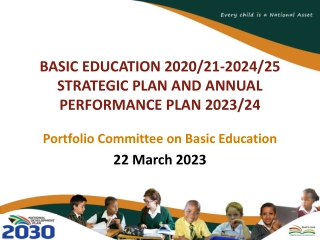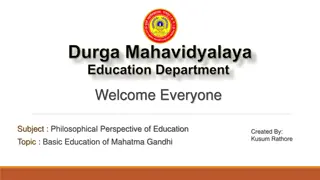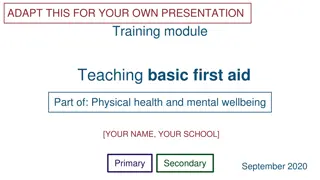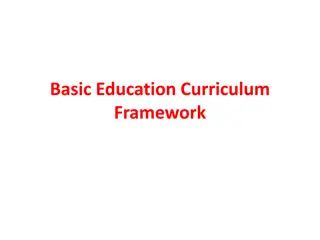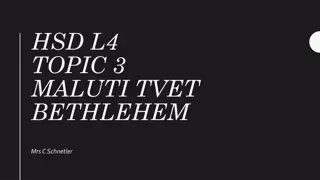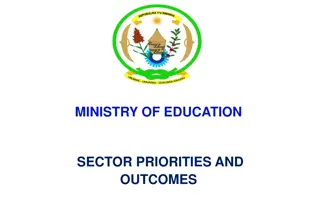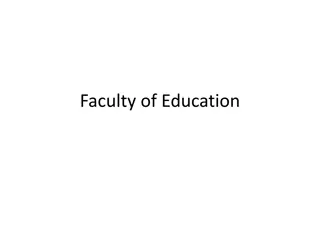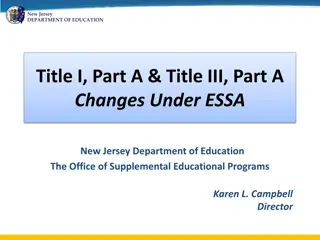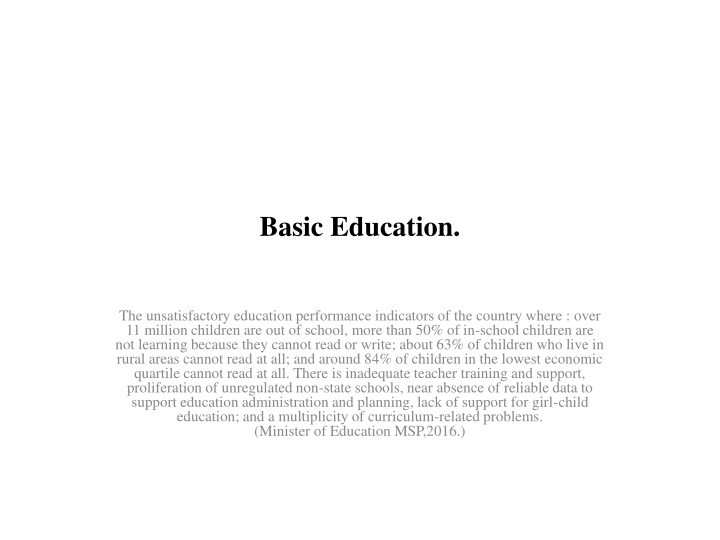
Challenges and Solutions in Nigerian Basic Education
Explore the critical issues affecting basic education in Nigeria, including high out-of-school rates, lack of teacher support, and curriculum problems. Discover the key concerns for disadvantaged groups and the urgent need to increase enrollment rates for out-of-school children.
Download Presentation

Please find below an Image/Link to download the presentation.
The content on the website is provided AS IS for your information and personal use only. It may not be sold, licensed, or shared on other websites without obtaining consent from the author. If you encounter any issues during the download, it is possible that the publisher has removed the file from their server.
You are allowed to download the files provided on this website for personal or commercial use, subject to the condition that they are used lawfully. All files are the property of their respective owners.
The content on the website is provided AS IS for your information and personal use only. It may not be sold, licensed, or shared on other websites without obtaining consent from the author.
E N D
Presentation Transcript
Basic Education. The unsatisfactory education performance indicators of the country where : over 11 million children are out of school, more than 50% of in-school children are not learning because they cannot read or write; about 63% of children who live in rural areas cannot read at all; and around 84% of children in the lowest economic quartile cannot read at all. There is inadequate teacher training and support, proliferation of unregulated non-state schools, near absence of reliable data to support education administration and planning, lack of support for girl-child education; and a multiplicity of curriculum-related problems. (Minister of Education MSP,2016.)
With 11.4 million out-of-school children out of the 20 million worldwide, Nigeria has the highest number of out-of-school children in the world. These include the girl-child, almajiri-child, children of nomadic pastoralists, boy child drop-out, the area boys, children of migrant fishermen and more recently the children displaced by the Boko Haram insurgency.(Unicef.2015)
Among these disadvantaged groups: 60% of the 11.4 million out-of-school children in Nigeria are girls (UNICEF, 2015); only a fraction (17%) of the 4.1 million nomadic children of school-age have access to basic education despite decades of intervention. Similarly, an increasing number of displaced children (1 million according to UNICEF s 2015 estimate) are being forced out of school in the insurgency-stricken States. These figures suggest that the educational process has given these groups of disadvantaged children very little access to education.
The key issues and problems affecting the education of out-of-school children include: Socio-culturalfactors negative perception of the importance and value of western education low status accorded to girl-child education early marriage. Economic demand factors poverty of the family, child labour, distance from school limited employment opportunities for school leavers.
For the 11.4 million out-of-school children the most urgent concern is raising the enrollment rate to ensure that all of them are enrolled in basic education schools in the next four years. To achieve this target, Government must plan to:
Enroll 2,875,000 pupils annually for the next four years; Construct and furnish additional 71,875 classrooms annually for the next four years to accommodate the anticipated increase in enrolment; Recruit additional 500,000 qualified teachers (promised by the Federal Government) in tranches, to cater for the anticipated increase in pupils enrolment;
Raise the current enrolment of girls in basic education schools by 1.5 million girls annually, for the next four years if the 6 million girls currently out of school are to be provided with access to basic education as required by the UBE law; Raise the current enrolment in Nomadic schools from the present 17% to 30-40%
Supply side factors non-availability of schools in some communities, learner-unfriendly school environment, lack of provision for the education of special needs learners incessant teacher strikes, shortage of teachers and caregivers at all levels Politics and governance low level of political will politicization of education weak school level governance poor financing of education.
recruit 37,500 qualified female teachers, (or 7.5% of the new teachers promised by federal government) annually, to serve as role models; Provide staff housing or special allowances as incentive for teachers in rural areas; determine the amount of resources in terms of the learning materials and other facilities, as specified in UBEC s school norms and standards, required for attaining these targets;
Introduce two streams system, i.e morning and afternoon, where necessary in the short term while constructing classrooms and providing furniture.
The key factors that impede the attainment of the national targets and the full achievement of SDG Targets include: Inadequate funding Poor quality of teachers Dilapidated and inadequate classrooms, furniture, sanitary, and toilets facilities. Dearth of textbooks and other instructional materials. (The textbook-pupil ratio in some States ranges from 1:5 to 1:9). This has had adverse effect on the quality of tuition provided in schools.
In terms of human resources, there is a general lack of capacity at State and LGEA levels to implement UBE. Very weak monitoring systems at the three tiers of government. Dearth of reliable data for planning and evaluating progress against set targets. Socio-cultural barriers that impede female participation in basic education. Lack of enforcement of the UBE Act 2004, on enrolment and retention.
Inability of some States to access the UBE Intervention funds as and at when due. Inadequate deployment of ICT in basic education delivery. Mismanagement of funds meant for basic education. Inadequate enforcement of UBE Act 2004.
Strategies for addressing the issues and Challenges of Basic Education i)Community mobilization and sensitization at LGEA levels aimed at boosting enrolment. ii)Provision of support to States to establish new schools, provide furniture, construct and furnish additional classrooms in existing schools and renovate all dilapidated classrooms and other teaching-learning facilities; iii)Collaboration with States to provide textbooks and instructional materials and thereby improve the textbook-pupil ratio in primary and JSS;
i)Establish new schools and provide the requisite teaching-learning facilities and instructional materials aimed at broadening access to disadvantaged groups, e.g nomadic groups, and the handicapped. ii)In order to broaden access to education for girls, roll out the GEP programme nationwide so as to boost enrolment for girls; iii)Support States to establish Special Schools for Girls in States that have low participation rates for girls; iv)Provide Special schools to broaden access to children with special needs and make all schools accessible to children with special needs; v)Enforce the provisions of the UBE Act 2004 on parents who fail to enroll their school age children; vi)Complete the process of reviewing the UBE Act 2004 which was initiated by the 7th National Assembly and expand its legal scope in order to include ECCDE and senior secondary education in matters of funding and management and Adult and Non-formal Education in matters of funding only. vii)Implement properly Section3 of the Act. on the Services to be provided in public basic schools defined by the Act. As books, instructional materials, classroom furniture and free lunch.
vii)Recruit and train the 500,000 teachers promised in the national budget and post them based on need, not equality of States; Support teacher training institutions to expand their teacher upgrading programmes and thereby upgrade all unqualified teachers to NCE level;
viii)Ensure the use of the new NCE curriculum in all CoEs; ix)Support States to replicate and roll out the re-training of primary school teachers currently being supported by IDPs; x)Re-structure and strengthen the Education Quality Assurance Service at the three tiers of government; xi)Provide incentives to attract and retain competent teachers in rural areas using part of the UBE intervention funds; xii) Re-invigorate the Education Management Information System (NEMIS) through capacity building and adequate funding so that it is transformed into an effective and reliable data base for education in Nigeria; xiii)Conduct annually, the Monitoring of Learning Achievement (MLA) of primary school pupils and JSS students; xiv)Support the establishment of and or strengthen the Education Management Information System (EMIS) in States and LGAs;
xv)Coordinate with the States in the design and implementation of training programmes that will enhance the capacity of basic education teachers to deliver basic education; xvi)Provide qualified teachers for children with special needs; xvii)implement the policy on special needs education; xviii)Improve the quality of teaching and learning of science and mathematics; xix)Provide education marshals in every State to apprehend out-of-school children; and xx)Review the process of accessing UBE intervention funds by States.
xxi)Find a lasting solution to the failure of states to access the UBE grants including matching grants making the implementation of basic education to be very poor in the country. xxii) As at 30th June,2017 less than half of the states of the Federation including the FCT have accessed their grants for 2016. xxiii) About twelve states are yet to access their 2015 grants. xxiv) The UBEC should decentralize the procurement of text books to the State UBE Boards. This will give UBEC the over site powers to ensure utilization. xxv) The UBEC should provide grants(service) for the school lunch as provided by the Act. to the states UBE Boards who should also empower the Local Education Authorities (LEA) to execute and both the State UBE Board and UBEC can monitor proper utilization. xxvi) Decentralize the procurement of instructional materials to the Local Education Authority (LEA)and provide the mechanism of ensuring proper utilization.

